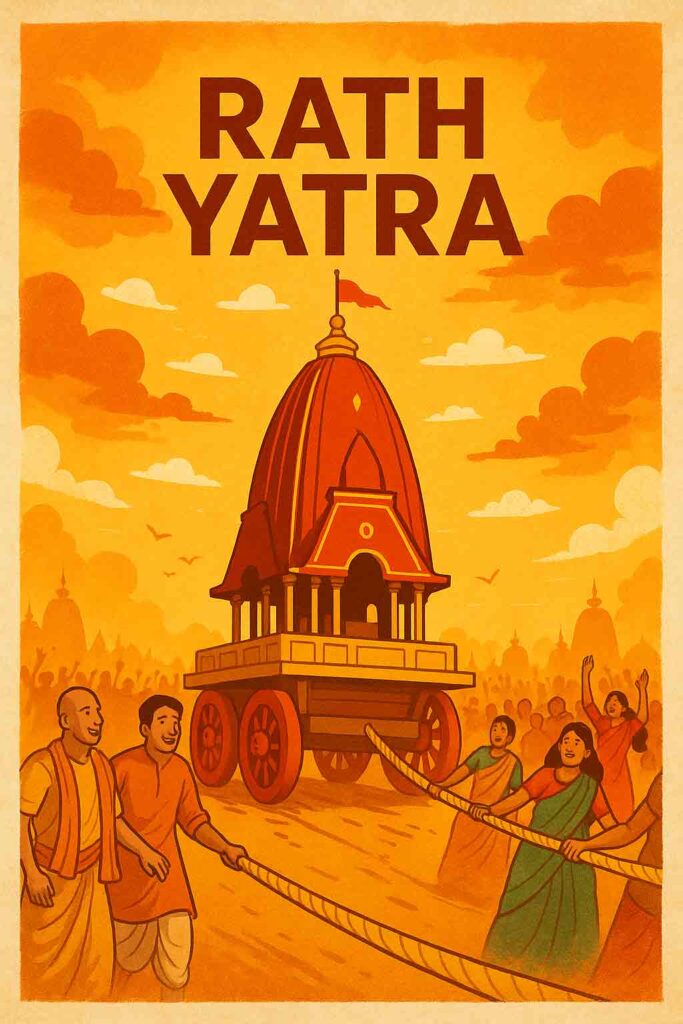Rath Yatra (June–July)
Chariot festival of Lord Jagannath

Rath Yatra, also known as the Chariot Festival, is one of the grandest and most celebrated Hindu festivals in India, dedicated to Lord Jagannath (a form of Lord Vishnu), his brother Balabhadra, and sister Subhadra. The festival, held annually in the sacred city of Puri in Odisha, attracts millions of devotees from across India and the world. The word “Rath Yatra” literally translates to “Chariot Journey”, symbolizing the divine journey of the deities from their main temple to another temple, signifying the Lord’s visit to his devotees. This festival, marked by devotion, color, music, and enthusiasm, reflects the deep spiritual bond between the divine and humanity and celebrates inclusivity, unity, and faith.
The central event of the Rath Yatra is the grand procession of the three majestic chariots carrying the idols of Lord Jagannath, Lord Balabhadra, and Devi Subhadra from the Jagannath Temple to the Gundicha Temple, about three kilometers away. Each deity has a beautifully crafted wooden chariot made anew every year using sacred neem wood, following centuries-old traditions. The chariots are massive structures, towering up to 45 feet high, adorned with bright colors, intricate designs, and canopies of red, yellow, green, and blue. The chariot of Lord Jagannath, called Nandighosa, has 16 wheels; Balabhadra’s chariot, Taladhwaja, has 14 wheels; and Subhadra’s chariot, Darpadalana, has 12 wheels. Thousands of devotees, regardless of caste, creed, or social status, gather to pull the ropes of these chariots, as it is believed that pulling the chariot grants immense spiritual merit and the blessings of Lord Jagannath himself.
The Rath Yatra holds immense religious significance. It is believed that Lord Jagannath, along with his siblings, travels to the Gundicha Temple, which is considered to be the home of their aunt. The journey symbolizes the Lord’s desire to come out of the temple to bless all devotees, including those who cannot enter the sanctum sanctorum due to traditional restrictions. This act of accessibility makes the festival a symbol of equality and inclusiveness in Hindu spirituality. After spending nine days at the Gundicha Temple, the deities make their return journey, known as the Bahuda Yatra. The return procession is equally festive, filled with chants, drumbeats, dancing, and joyous devotion.
The festival’s origins are deeply rooted in mythology and tradition. It is said that the practice of Rath Yatra dates back thousands of years and is mentioned in ancient Puranas like the Skanda Purana, Padma Purana, and Brahma Purana. According to one popular legend, the divine siblings longed to visit their birthplace, Gundicha Temple, which represents their maternal home, and thus began the annual chariot journey. Another belief associates the festival with Lord Krishna’s return to Vrindavan, symbolizing his eternal bond with his devotees. The rituals associated with Rath Yatra start much earlier with Snana Purnima (the bathing festival), followed by a fortnight-long period known as Anasara, during which the deities are believed to fall ill and remain in seclusion before appearing again in public during the Yatra.
Apart from Puri, Rath Yatras are celebrated in many parts of India and abroad, especially in places with large Jagannath temples such as Ahmedabad, Kolkata, and Delhi. The International Society for Krishna Consciousness (ISKCON) has popularized the festival globally, and today, Rath Yatras are held in major cities like London, New York, Sydney, and Singapore, drawing devotees from all backgrounds. The atmosphere during the festival is electrifying—streets are filled with devotees singing devotional hymns, chanting “Jai Jagannath!”, and dancing in divine ecstasy. Vendors sell traditional sweets like khaja and poda pitha, while temples and homes are decorated with flowers and lights, enhancing the festive spirit.
Beyond its religious fervor, the Rath Yatra embodies profound philosophical meaning. It represents the journey of the soul toward liberation (moksha), guided by divine will and devotion. The pulling of the chariot symbolizes the effort one must make to move closer to the divine by overcoming worldly attachments. The festival teaches humility, service, and unity, reminding devotees that the divine resides not only in temples but within every heart that seeks with love and sincerity. Rath Yatra thus transcends mere ritual—it is a celebration of faith, devotion, and the eternal bond between God and humanity.
